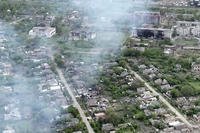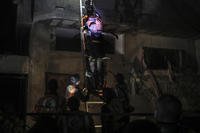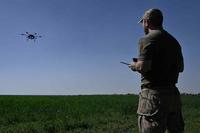Is it possible to tie the theories of early air power enthusiasts such as Guilio Douhet and Curtis Lemay to the strategic debate over the way ahead in Afghanistan? Absolutely, according to Brig Gen. H.R. McMaster, who sees strategic bombing theory at the root of the claim by some that aerial drone strikes operating in conjunction with special operations units on the ground can eliminate the Taliban in Afghanistan.
The debate over U.S. strategy in Afghanistan has settled into a choice between the highly labor intensive counterinsurgency approach, which seeks to protect the population, versus what McMaster calls the “raiding” approach (also often called the counter-terrorism approach), which would rely primarily on overhead sensors and stand-off precision strike to at least contain the influence and movements of extremist fighters in Southwest Asia.
That latter approach won’t fly, said McMaster, one of the Army’s leading counterinsurgency proponents. Speaking at a most informative conference last week put on by the Marine Corps University, he said the approach (supported most famously by conservative pundit George Will) was a seductively easy approach to a complex situation. In reality, "it's very problematic because it doesn’t address the fundamental causes of violence and insecurity… In fact, in many ways it can strengthen the enemy because the actions you take reinforces the enemy’s narrative and propaganda campaign.”
Air power theorists found eager audiences among post-World War I populations weary of the daily slaughter of industrial age warfare. Applied to conventional state-versus-state warfare, the theories said aircraft would fly far behind the front lines to strike an enemy’s factories, storage depots and transportation nodes, crippling its ability to fight. It's no wonder similar theories are gaining ground eight years into a costly war that shows no signs of ending.
The aerial raiding approach, reportedly favored by Vice President Joe Biden, not only appeals to policymakers in Washington with an eye towards slipping American support for the war, but also to certain segments of the military, McMaster said, because it offers immediate feedback and ready metrics in terms of how many enemy killed.
The raiding approach is also rooted in the ideas of “nodal analysis” that were very popular in the 1990s, he said. “If you look at an enemy’s conventional organization… and you just get visibility on that organization and you figure out where those key nodes are and you attack those key nodes very precisely, that organization will collapse," he said. "This has been grafted to some degree onto the problems of terrorism and insurgency that we face today.”
Part of the problem is actually identifying the Taliban’s “center of gravity,” a key element for such an approach. Taliban operations are being run out of Quetta, Pakistan; hence the military’s acronym for the Taliban writ large in Afghanistan is “QST”: Quetta Shura Taliban. The QST lacks an easily targetable centralized means of production or political base. It’s a fluid collection of guerrilla networks and cells. Decapitation strikes do not apply as the organization is too fragmented. Even an exceptionally fortuitous strike that caught the entire QST leadership together would not permanently cripple the Taliban.
Counterinsurgency theorists and, more importantly, Afghan commander Gen. Stanley McChrystal, contend the enemy’s center of gravity is the Afghan population. Win the support of the population, win the war. Yet, as McChrystal laid out clearly in his strategic review, that approach requires enormous commitment of men, money and materiel.
"Simply addressing terrorism is missing the causes of terrorism," said Col. Daniel Roper, director of the Army-Marine Corps Counterinsurgency Center at Ft. Leavenworth, in a recent call when I asked him about the viability of the raiding approach. "Simply going after the bad guys after they’ve done something incredibly bad is really treating the illness after the patient is incredibly sick."
By contrast, the counterinsurgency approach, which focuses on addressing the local population’s discontent at the local level, by improving and adapting existing governance structures, gets at the root causes of the insurgency, he said.
The Taliban creates grievances and insecurity among the local population, said McMaster, and then blame it on somebody else, such as the central government. One of the more effective tools available to the counterinsurgent is to trace those grievances back to the enemy. "If people say we don’t have any power in this area, we say, 'Why don’t you have power?' We’ve been trying to put power in here but anybody who repairs the power lines gets shot," McMaster noted.








